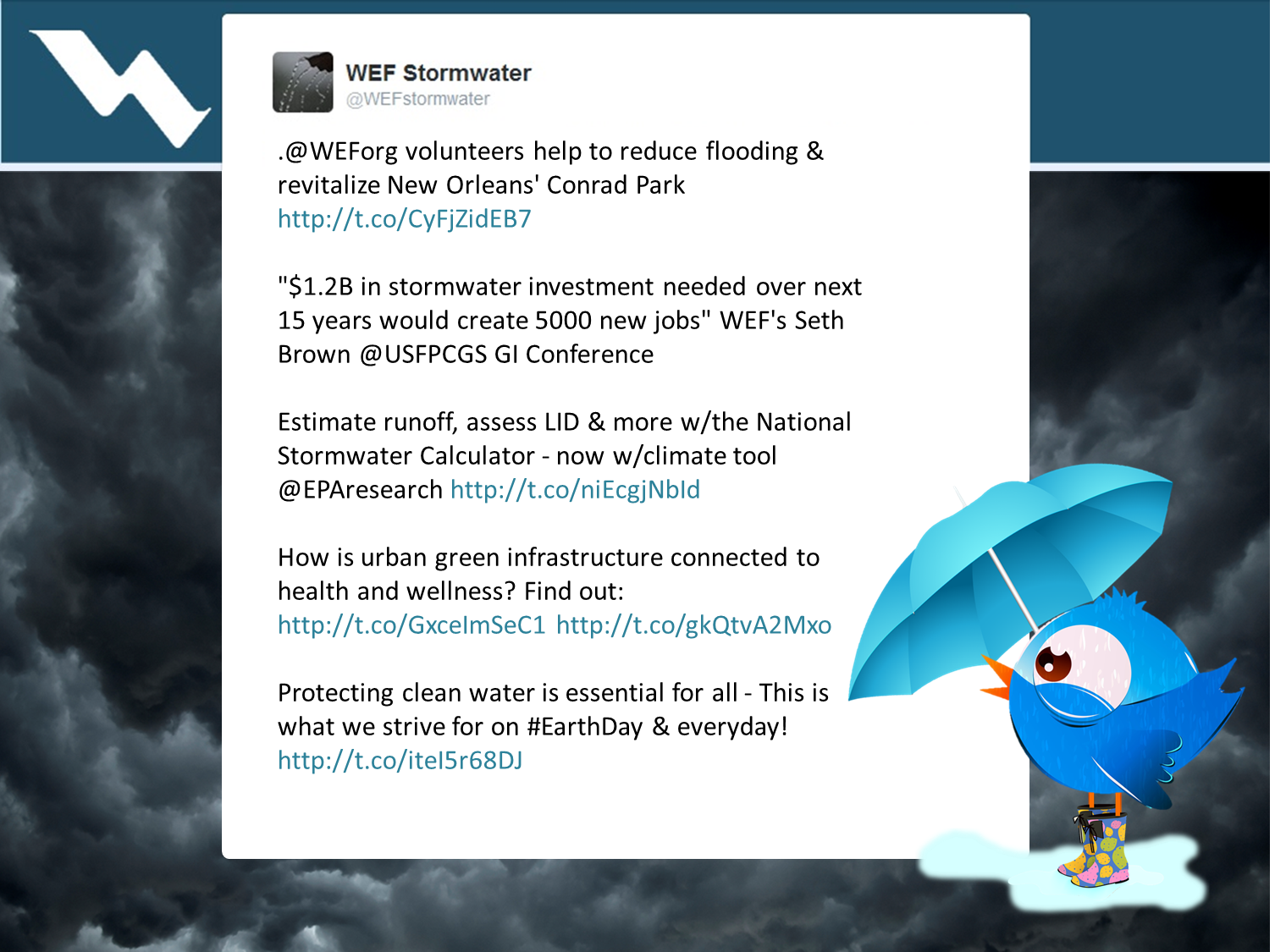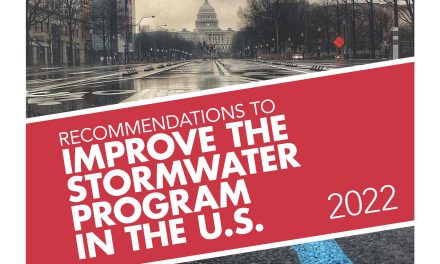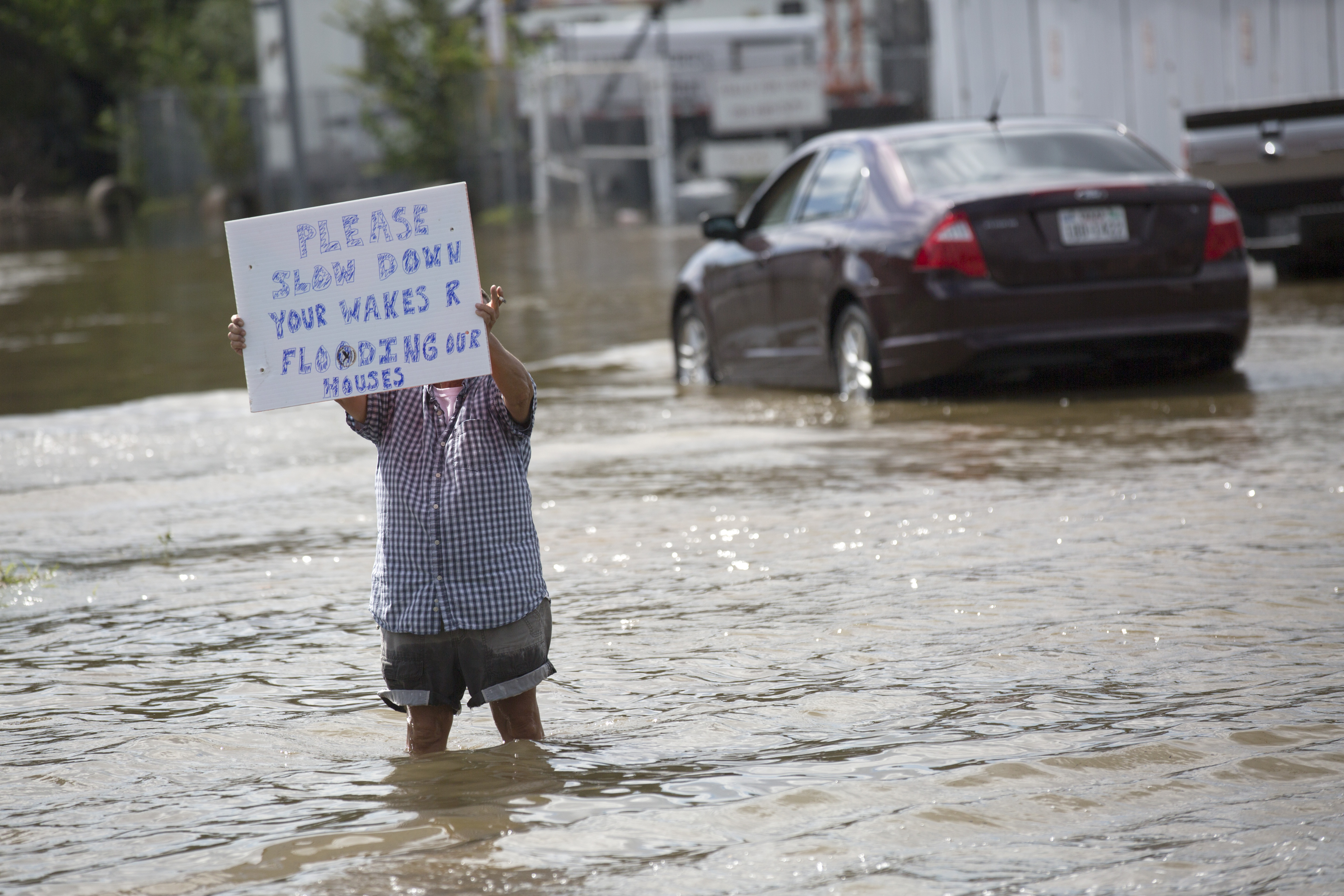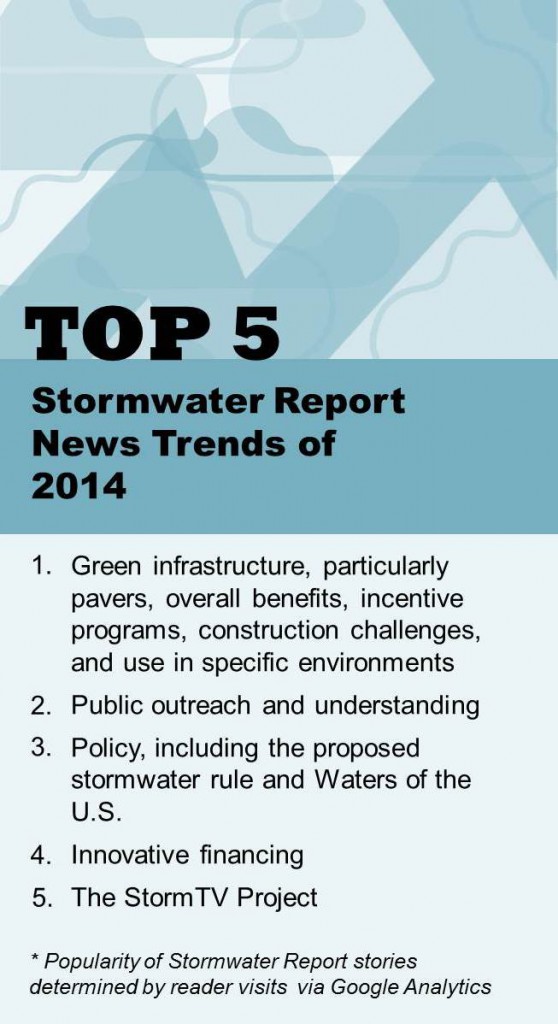 As water pollution from point sources continues to decline, focus is increasingly shifting toward water quality degradation caused by stormwater runoff. As recognition of stormwater issues continues to grow, the stormwater sector also expands and along with it policies, innovative technologies, public communication efforts, professional training, and more. Additionally, new challenges arise, from green infrastructure maintenance to climate change resiliency.
As water pollution from point sources continues to decline, focus is increasingly shifting toward water quality degradation caused by stormwater runoff. As recognition of stormwater issues continues to grow, the stormwater sector also expands and along with it policies, innovative technologies, public communication efforts, professional training, and more. Additionally, new challenges arise, from green infrastructure maintenance to climate change resiliency.
In 2014, policy issues, including the deferment of the proposed stormwater rule and comments on the Waters of the U.S. proposed rule, dominated stormwater industry discussions. However, adequate funding, green infrastructure, nutrients, and climate change were also among hot topics in stormwater sector news this past year. At the Water Environment Federation, 2014 highlights included the second annual Stormwater Congress, the Stormwater Testing and Evaluation for Products and Practices program, and more. Take a trip back through 2014 under the stormwater lens.
Policy and Legal Issues
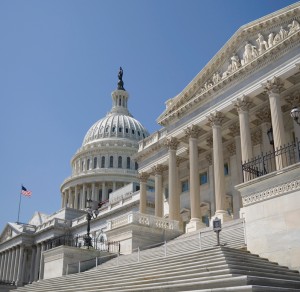
Policy issues, including the Waters of the U.S. proposed rule and deferment of the proposed stormwater rule, dominated stormwater industry discussions in 2014.
Deferment of the Proposed Stormwater Rule
Perhaps the biggest news of 2014 was the deferment of the U.S. Environmental Protection Agency’s (EPA) proposed stormwater rule. The rulemaking was an effort to overhaul the Federal stormwater program. In March, the agency announced its intentions to refocus resources in light of continuous delays in proposing the national stormwater rule, a commitment made as part of litigation by the Chesapeake Bay Foundation in 2009.
As part of the proposed rule, the agency wanted to focus on integrating urbanizing areas located beyond the limits of currently regulated areas into existing Municipal Separate Storm Sewer System (MS4) programs. EPA also discussed a retrofit requirement for some Phase I communities, and most significantly, a retention-based national performance standard for new development and redevelopment activities based likely upon percentile stormwater capture.
In lieu of the national rule, however, EPA has said it plans to improve stormwater management and encourage infiltration practices through existing Clean Water Act authorities, such as MS4 permits and total maximum daily loads (TMDL). EPA also is looking to reduce its backlog of MS4 permits, with some 50% of Phase II and 25% of Phase I MS4 permits expired or being administratively continued. Further, the agency has and will continue to provide incentives, technical assistance, and other approaches to help localities address stormwater runoff.
However, discrepancies exist between the EPA’s focus on numeric, measurable targets for stormwater and the Clean Water Act’s call for reducing pollutants to the maximum extent practicable. Additionally, the end of 2014 saw the agency’s budget slashed by $60 million in the Fiscal Year 2015 omnibus appropriations package. The bill also reduced EPA staffing to numbers equal to those in 1989.
A New Program Vision for TMDLs
At the beginning of 2014, EPA announced a new program vision for TMDLs that incorporates experience gained over the last two decades from developing nearly 65,000 TMDLs. The new vision focuses on improving how states establish and prioritize impaired waters. It should provide states with more flexibility and allow them to tailor their program to meet specific needs and goals. State activities also would be incorporated into a national restoration program, and the plan includes a new focus on maintaining and protecting healthy waters.
Additionally, in November, EPA announced a final version of the Stormwater TMDL memorandum that was originally released in November 2010. The final version removes language regarding the use of flow as a surrogate. The flow-based TMDL approach proposed using surrogates, such as stormwater runoff or impervious cover, for pollutant loadings, such as sediment or nutrients, in waterbodies. While this approach has been used in EPA Region 1, it was challenged in Region 3 and 7.
Further, in the memorandum, EPA seems to have heeded public comments, which asked for specific examples on how to include water quality-based effluent limits (WQBELs) and wasteload allocations in permits. The agency refers to its MS4 compendium, also released this year, which highlights examples of WLA integration into MS4 permits from across the country.
Waters of the U.S. Proposed Rule
In November, the comment period closed on the EPA and U.S. Army Corps of Engineers’ (Corps) proposed Waters of the U.S. rule. The proposed rule seeks clarify whether various waters and wetlands are jurisdictional under the Clean Water Act. According to EPA and the Corps, the rule would subject approximately 3% more U.S. waters to Clean Water Act jurisdiction and generate as much as $514 million annually in public benefits, such as reduced flooding and groundwater recharge. Industry groups and others in the sector challenged these findings. Further, in comments, some in the stormwater sector called for refinement and additional clarity on terms such as “significant nexus,” “adjacent waters,” “other waters,” and “tributaries.” For instance, the tributary definition and its potential impacts on ditches could inadvertently affect green infrastructure adoption. The rule also should clarify which ditches are, or are not, jurisdictional.
Additionally, EPA and the Corps do not intend for traditional stormwater practices or green infrastructure facilities to be considered jurisdictional Waters of the U.S., but the lack of language explicitly outlining the exclusion of these systems leaves the rule open to legal interpretation. There is emerging consensus within the stormwater sector that an exemption should specifically include MS4 infrastructure and stormwater runoff controls. WEF called for this exemption in its comments on the proposed rule.
Integrated Planning, Construction Effluent Limitations, and More
Launched in 2012, EPA’s integrated planning framework is intended to help municipalities prioritize clean water projects. Though many plans are in the works, until November of 2014, no plans had yet been approved. A Clean Water Act settlement with the City of Lima, Ohio, negotiated over the past 10 years, is the first consent decree built on the agency’s new framework. The consent decree gives Lima 24 years to fully comply by addressing combined sewer overflows (CSOs) released into the Ottawa River. Additionally, it allows the city to prioritize the most environmentally beneficial projects and modify decree provisions based on financial capabilities.
To help communities develop a more accurate and complete picture of their ability to pay for Clean Water Act obligations, emphasizing factors beyond the 2% threshold for median income, EPA also recently released its financial capability framework.
Also in 2014, after six years of litigation, the Supreme Court declined Los Angeles County and its Flood Control District’s request to review a 9th Circuit Court of Appeals ruling. For now, the ruling that found the county and district liable for violating water quality standards established in a 2001 stormwater permit will stand. The county and district’s liability was established based on downstream monitoring of the Los Angeles and San Gabriel rivers. However, monitoring also reflected discharges from thousands of sources, including municipalities, sewage treatment plants, and industries.
In March, EPA published its final rule on effluent limitations for construction and development. The rule necessitates the use of best management practices (BMP) to control stormwater and minimize erosion rather than setting numeric turbidity effluent limits. And in December, EPA published a Supplemental Notice to its 2013 proposed NPDES Electronic Reporting Rule. The proposed rule requires electronic reporting instead of current paper-based NPDES reports. The supplemental notice seeks to respond to some comments on the proposed rule while opening a new public comment period.
Finally, 2014 was also a year of bans on some of the litter and debris most harmful to aquatic systems, including plastic bags, Styrofoam, and microbeads. In June, Illinois became the first state to ban the manufacture and sale of personal care products containing synthetic plastic microbeads. Microbeads are commonly used as exfoliants and are found in more than 100 products, including toothpaste and face scrubs. In many cases, these microplastics make their way into natural waters because they are not removed during wastewater treatment due to their size and buoyancy. In July, Washington, D.C. Mayor Vincent Gray signed a law banning the use of Styrofoam in the District. Then in September, California became the first to initiate a statewide ban on single-use plastic bags, and the European Union also agreed to reduce plastic bag use in November.
Stormwater Funding

Despite stormwater utilities growing prevalence and the need to generate funding for stormwater programs, many communities still face opposition to stormwater fees. However, many communities are forging ahead with innovative financing mechanisms.
A Black & Veatch survey of 78 stormwater utilities released in September of 2014 called adequate funding for stormwater programs the highest sector priority and greatest challenge, even for those utilities with dedicated user fees.
According to a 2012 survey by Western Kentucky University, 1400 to 2000 localities charge stormwater fees, which average $4.20 per month for single-family residential properties. These fees are more common in the Midwest, the Pacific Northwest, and Southern Atlantic states, the report says. However, despite stormwater utilities growing prevalence and the need to generate funding for stormwater programs, many communities still face opposition to stormwater fees.
For instance, in September, the Ohio Supreme Court heard a stormwater fee case raised by the Northeast Ohio Regional Sewer District (NEORSD). The fee, established to pay for NEORSD’s separate stormwater management program, was challenged in court by eight communities in the Greater Cleveland area. These communities called the fee a tax that was not voted for. The Ohio Supreme Court also seeks to determine whether NEORSD has the authority to create and implement a regional stormwater management program and fees when the program is not associated with combined sewer systems.
In Maryland, negative press surrounding stormwater fees, which have been derisively dubbed a “rain tax,” may have played a role in the Nov. 4 election in a state where registered Democrats outnumber Republicans 2 to 1, according to news sources. Maryland’s new Gov.-elect Larry Hogan (R) has said he wants to repeal a state law requiring stormwater fees in Baltimore and 10 of the state’s other most populous counties. In November 2014, Colorado Springs residents voted to reject a plan to create a regional stormwater authority and its associated fees. This decision has put the city at risk for litigation related to its stormwater permit.
According to the National Association of Clean Water Agencies (NACWA), most stormwater fees withstand legal challenge, but only after utilities have spent extensive time and resources in litigation. However, there is always the potential that the program or fee could be struck down, leaving a utility in the position of being legally responsible to comply with the Clean Water Act yet unable to administer and fund the program. In November, NACWA released an analysis of stormwater program fee litigation. The white paper provides analysis of legal issues affecting stormwater funding programs to equip utilities with critical knowledge and tools to inform and prepare them for creating, implementing, or defending a stormwater program, utility, or fee.
However, 2014 was also a year for innovative financing and public-private partnerships. The year kicked off with the continuation of the EPA’s Faster-Cheaper-Greener webcast series, hosted in cooperation with the Water Environment Federation (WEF).
With limited funding and public space for green stormwater infrastructure, many communities are looking at ways to engage the private sector. In July, Philadelphia launched a Greened Acre Retrofit Program, a companion to the city’s Stormwater Management Incentives Program. Paid for by stormwater fees, both are grant programs for non-residential Philadelphia Water Department customers that further encourage private participation in design and construction of stormwater retrofit projects.
Additionally, in September, the District Department of the Environment (DDOE) in Washington D.C. approved the first trade in its nascent Stormwater Retention Credit (SRC) trading program, which is also the first of its kind in the nation. Recognizing that it would be relatively difficult or costly for some regulated projects to achieve onsite retention standards specified in Washington D.C.’s stormwater permit, a percentage can be achieved offsite by purchasing SRCs, paying an in-lieu fee, or a combination of both. Goals of the program include increasing green infrastructure installation on private property and accelerating green retrofits.
In November, Prince George’s County, Maryland officially kicked off a first-of-its-kind, community-based, public-private partnership with Corvias Solutions. This 30-year partnership came to fruition after a unanimous decision by the Prince George’s County Council and more than a year’s worth of negotiations. The partnership will address stormwater management requirements under the Federal Chesapeake Bay TMDL, which requires Prince George’s County to retrofit 3240 impervious hectares (8000 ac) within a 10-year time frame. Through the partnership, the retrofits are expected to take less time, provide significant cost-savings, and add up to 5,000 new entry-level green jobs in the county. Under the terms of the partnership, the county will invest $100 million in the initial three-year retrofit, and Corvias will manage the design, construction, and long-term maintenance of stormwater management systems for up to 1620 impervious hectares (4000 ac).
Green Infrastructure

Communities continue to incorporate green infrastructure solutions into stormwater permits, consent decrees for sewer overflows, and TMDLs. With these requirements comes a need for training, and some communities are building expertise in part through LID design competitions. Despite these successes, there are still challenges to overcome.
Additionally, the year of 2014 has seen growing support for infiltration-based stormwater management practices. At the interactive EPA Innovation Blueprint session on greening water infrastructure at the 2014 Stormwater Congress, attendees noted successes so far include regulatory requirements for low impact development (LID), implementation of LID, and grassroots green infrastructure movements. Additionally, communities continue to incorporate green infrastructure solutions into stormwater permits, consent decrees for sewer overflows, and TMDLs.
Many communities, including Philadelphia and Northeast Ohio, have reduced the cost of mitigating CSOs by incorporating green infrastructure into long-term control plans. Just this year, New York City announced an expansion of its green infrastructure program, Buffalo committed $93 million to green infrastructure, and Washington DC announced that it will invest $100 million in green infrastructure. Allegheny County Sanitary Authority also will renegotiate its consent decree to include green solutions. To help communities, EPA released the report “Greening CSO Plans” in March of 2014.
Attendees at the EPA Innovation Blueprint session did call lack of workforce training and turnover a barrier to green infrastructure implementation as well as a must-have for success. However, this past year did see the start of new training programs focusing on green infrastructure and stormwater management. For instance, the Colorado Department of Transportation rebooted its Transportation Erosion Control Supervisor (TECS) Certification program and opened a state-of-the-art, hands-on Water Quality BMP Training Facility. EPA hosted a green infrastructure training webcast series, and StormwaterPA, an initiative of the Philadelphia-based nonprofit communications organization, GreenTreks Network, Inc. released a green jobs training module.
Additionally, an innovative way of building support and expertise for LID are design competitions. In 2014, two Tennessee localities, Chattanooga and the City of Memphis-Shelby County, as well as Northeast Oklahoma and Washington DC announced winners to LID design competitions while Tacoma, Washington launched a competition at the end of the year. EPA also awarded the winners of its second annual Campus RainWorks Challenge, a green infrastructure competition for university students, and launched its third competition in July.
Despite successes, there are still green infrastructure barriers to overcome. Some listed at the Innovation Blueprint session include maintaining distributed stormwater controls and lack of maintenance enforcement, quantifying green infrastructure benefits and life cycle performance, funding, and solutions for regional weather considerations, such as green infrastructure in semi-arid climates. Interest in these topics was echoed by Stormwater Report readers.
Climate Change
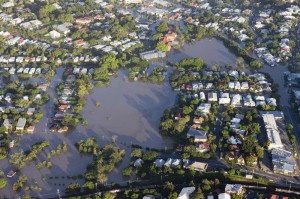
Climate change is expected to cause more intense storms and flooding, more severe droughts, and worsening water quality. Green infrastructure has been identified as a key component of climate resiliency initiatives, to combat both drought and flooding.
The U.S. National Climate Assessment and Intergovernmental Panel on Climate Change’s (IPCC) Fifth Assessment Report, both released in 2014, reiterate top water concerns related to climate change, including more intense storms and flooding, more severe droughts, and worsening water quality. Green infrastructure has been identified as a key component of climate resiliency initiatives, to combat both drought and flooding. As distributed systems, green practices can be complementary to centralized infrastructure and offer a piecemeal approach by which to expand stormwater management facilities at a lower cost over time.
In February of 2014, EPA released an update to the National Stormwater Calculator, adding a climate assessment tool that allows the calculator to assess future climate vulnerability scenarios. The calculator now includes changes in seasonal precipitation levels, the effects of more frequent high-intensity storms, and changes in evaporation rates based on scenarios validated by the IPCC.
In the fall, the Obama Administration announced new executive actions and its Climate and Natural Resources Priority Agenda, which will support investments in green infrastructure and improve natural resources management in the context of a changing climate. Included among these actions was the creation of the Green Infrastructure Collaborative. During the kick-off event held by EPA at the White House campus in October, WEF, along with other private- and public-sector organizations, committed to support the advancement of green stormwater infrastructure.
Further, natural systems, such as wetlands and oyster reefs, also are being increasingly touted as a way to improve cities’ resiliency to climate change, as they can buffer the effects of intense storms, flooding, and sea level rise. In June 2014, the U.S. Department of Housing and Urban Development (HUD) announced the winners of its Rebuild by Design competition, which sought to rebuild and improve the resiliency of areas affected by Hurricane Sandy. Among the winners, a $335 million flood barrier and LID project called the BIG U will be installed along Manhattan’s Lower East Side. Additionally, the competition will fund a $60-million living breakwater along Staten Island’s South Shore. In September, HUD launched a $1 billion National Disaster Resilience Competition as a follow up to Rebuild by Design.
A National Oceanic and Atmospheric Administration study released in July examined more than 60 years of coastal water level and local elevation data changes and found that nuisance flooding is an increasing problem as coastal sea levels rise. All U.S. coasts are affected, with increases ranging between 300% and 925% compared to 1960s levels. While flooding across the nation has brought greater recognition to the risks posed by climate change, California has been in its worst drought in 160 years of recordkeeping and announced a Drought State of Emergency in January 2014. In December, however, some areas of the state received more than 3 in (76 mm) of rain in an hour. Fortunately, cities like Los Angeles are using techniques such as spreading grounds, cisterns, and green infrastructure to take advantage of the rain, harvesting it for later use.
Nutrients
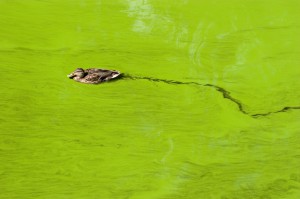
Algal blooms came to the forefront of national attention this year and brought nutrient issues into sharper focus. Managing stormwater on agricultural lands is an important aspect of controlling nutrient pollution, and water quality trading may be one solution to this challenge.
Another challenge expected to be exacerbated by climate change is the issue of algal blooms, which came to the forefront of national attention in early August. Toledo, Ohio issued warnings to nearly half a million people not to use drinking water for cooking, bathing, or consuming due to cyanobacteria toxins known as microcystins.
Subsequently, nutrients also came into sharper focus as a primary cause of algal blooms. Reducing nutrients in runoff is paramount to protecting waterbodies, and is a significant focus in the Great Lakes, Chesapeake Bay as well as the Mississippi River Basin and Gulf of Mexico. Earlier this year, the EPA Office of the Inspector General called for a more uniform and comprehensive measurement and accountability system to better track nutrient discharges to the Gulf of Mexico. And Chesapeake Bay Partners, which include bay and headwater states, signed a new watershed agreement. It is the first agreement since EPA released the 2010 bay TMDL, which is the largest and most complex TMDL to date, requiring bay states to implement pollution controls by 2025 capable of cumulative reductions of 25% nitrogen, 24% phosphorus, and 20% sediment.
In October 2014, USGS and the U.S. Department of Agriculture’s (USDA) Natural Resources Conservation Service announced a partnership to examine the benefits of voluntary agricultural conservation practices on water quality at a watershed scale. Perhaps the greatest hurdle to nutrient reduction is the fact that agriculture is a top contributor of nutrients, yet stormwater runoff is not regulated on agricultural lands. Stormwater management is instead encouraged through agricultural conservation practices, such as cover crops and buffer zones.
However, water quality trading offers a promising way to incentivize stormwater controls on agricultural and other private lands. Water quality trading has the potential to significantly reduce water pollution in river basins and estuaries faster and at a lower cost than requiring facilities to meet compliance costs on their own. At the very end of 2013, the USDA and EPA announced a partnership to further water quality trading. The National Network on water quality trading, a coalition of government officials and environmental and industry organizations, formed in January. The goal of the network is to establish a national dialogue and to “provide options and recommendations to improve consistency, innovation and integrity in water quality trading.” Currently, state and local trading programs exist across the country, but they all vary in nature and scope.
In August, the Willamette Partnership, Freshwater Trust, U.S. EPA Region 10, and state partners released draft recommendations on water quality trading approaches in the Pacific Northwest, and pilot projects were expected to begin in Oregon, Idaho, and Washington in 2014. Additionally, in March, the Electric Power Research Institute transacted the first interstate credits for nutrients in the United States, officially launching water quality pilot trades in the Ohio River Basin.
2014 at WEF
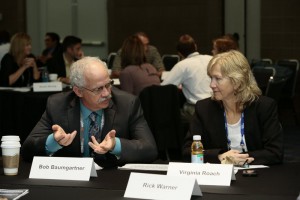
From hosting its second annual Stormwater Congress, to supporting stormwater product and practice evaluations, to hosting the first National Stormwater Summit (pictured above), 2014 has been a busy year for WEF. Throughout the year, WEF also continued its core mission to provide stormwater continuing education and advocacy with new regulatory comments, books, webcasts, magazines, and more.
In 2014, WEF saw continued growth of its stormwater program. In February, WEF’s Stormwater Testing and Evaluation for Products and Practices (STEPP) Task Force released a white paper with recommendations for a national program. The goal of STEPP is to build support around and develop a framework for a national testing and evaluation protocol for stormwater management practices and devices. This would help reduce cost and time barriers for companies looking to get innovative stormwater products to market. Over the year, WEF has gained more support for STEPP, including support from the Stormwater Equipment Manufacturers Association as well as other associations and state agencies.
At the end of September, WEF hosted its second successful Stormwater Congress, collocated with WEF’s annual conference, WEFTEC. It included more than 30 stormwater technical sessions and workshops, a sold-out luncheon, two receptions, as well as the Stormwater Pavilion, which is a concentrated area for exhibiting stormwater companies. This was the third year for the Stormwater Pavilion, and with more than 30 exhibitors spanning 372 m2 (4,000 ft2), its size was double last year’s pavilion.
At the Stormwater Congress, WEF also hosted the first National Stormwater Summit to bring together municipal stormwater leaders and other sector professionals. Meeting participants discussed the stormwater sector’s technical support and advocacy needs and how those needs can be addressed at the national level. Consensus was that WEF should take a national role in the sector, and convene future meetings.
In addition to its annual conference, WEF also provided education and training on stormwater throughout the year via avenues such as its monthly e-newsletter, The Stormwater Report; its quarterly magazine, World Water: Stormwater Management; and its webcast program, which this year provided information on innovative financing, STEPP, Waters of the U.S., stormwater control performance, and more.
Further, in August, WEF released two books related to stormwater. The first, Green Infrastructure Implementation provides actionable information pertaining to green solutions for stormwater management. The second book, Wet Weather Design and Operation in Water Resource Recovery Facilities, provides water professionals with a comprehensive reference of current design and operational practices for managing the unique challenges associated with wet weather flows.
Also in 2014, 25 expert judges rated more than 100 videos submitted to the StormTV Project, a stormwater video competition hosted by WEF. Through the 2012, 2013, and 2014 competitions, WEF has collected more than 220 videos highlighting green infrastructure, manufactured treatment devices, stream restoration, public education and more. These have been submitted by nonprofit organizations, government entities, consulting firms, and equipment manufacturers worldwide.
Finally, in 2014, WEF received a $25,000 grant from EPA to develop a national MS4 and green infrastructure recognition program, more to come on this in 2015.
Looking Ahead
In the coming year, WEF will host its annual Water Policy Forum and Fly-In, held in conjunction with the Water Environment Research Foundation and NACWA. The Fly-In will take place in mid-April followed by Collection Systems 2015 later that month. WEF’s newest magazine, World Water: Stormwater Management, which launched in 2013, also will go from quarterly to bimonthly (produced every two months). And of course, WEF will host the 2015 Stormwater Congress from September 26 – 30.
We look forward to what 2015 has to bring in the way of new stormwater research; policy updates, such as the final Waters of the U.S. rule expected in April; unique ways of communicating with the public, like the Facebook game “Stormwater Sentries” released this year; as well as innovative technologies and practices, such as using drones to aid in maintenance of stormwater management facilities. Over this new year, WEF will continue to provide current stormwater news, events, and information through The Stormwater Report. Thank you for reading!
Top 5 WEF Stormwater Tweets of 2014
